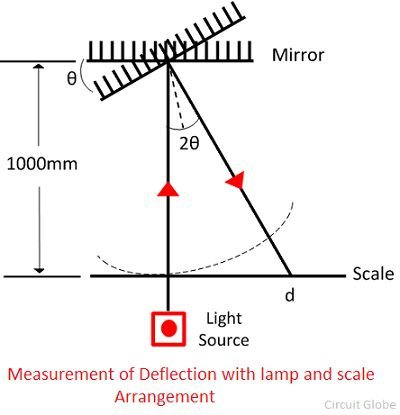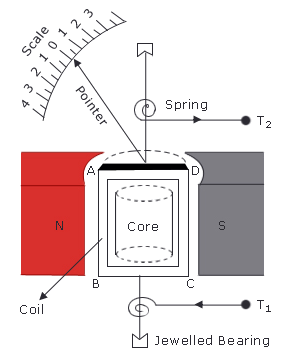Introduction to Galvanometer
Working principle:
Its underlying principle is the fact that when a current flows in a rectangular coil placed in a magnetic field it experience a magnetic torque, if it is free to rotate under a controlling torque, it rotates through an angle proportional to the current flowing through it. The rotation of the coil thus indicates a current flowing through it. Although the galvanometer deflects full scale by a small current( a few microamperes or milliamperes), neverthless it can measure such small currents if the deflection is properly caliberated.
Construction:

Credit
Its essential parts are as follows;
1) A permanent magnet whose pole piecex are made concave to make magnetic field radial and strong.
2) An rectangular aluminium frame mounted on a soft iron cylinder. Thin insulated copper wire is wounded on the frame, this forms the coil of the galvanometer.
3) A suspension fiber made up of phospor-bronze, one end of the suspension fiber is soldered with the coil and the other end is connected with the external terminal through mirror, its acts as a first current lead. The current which we want to detect enters to the coil of the galvanometer through suspension fiber.
4) A loose and soft copper spiral whose one end is soldered with the end of the coil and the other end is connected with the second external terminal. It acts as a second current lead.

Credit
5) A lamp and a scale arrangement.
Working:
A soft-iron cylinder coaxial with the pole pieces, is placed within the frame of the coil and is fixed to the body of the galvanometer. In the space between it and the pole pieces, where the coil moves freely, the soft iron cylinder makes the magnetic field stronger and radial such that into whatever position the coil rotates, the magnetic field is always parralel to its plane.
When a current passes through the galvanometer coil it experience a magnetic deflecting torque which tends to rotate it from its rest position. As the coil rotates it produces a twist to the suspension fiber. The twist in the fiber produces a restoring torque. The coil rotate until the elastic restoring torque due to the fiber does not equal and cancel the deflecting magnetic torque and then it attains equlibrium and stops rotating any further.
Defleting magnetic torque = BIAN cos α
Where
B= strength if magnetic field
I = current flowing through the coil
N= Number of turns in the coil
α= the angle between plane of the coil and magnetic field
The restoring elastic torque is directly proportional to the angle of twist of the suspension fiber it obeys hook's law. Thus restoring elastic torque is given as
Elastic restoring torque = cθ
Where θ is the angle of twist if the suspension fiber(θ is different from but proportional to α) and c is the torque per unit twist of the suspension strip.
For eqilibrium
Deflecting magnetic torque = Restoring eleastic torque
BIANcosα= cθ
I = (c/BNAcosα) θ
If the magnetic field were uniform (as with flat pole pieces) α would continously increase with θ and cosα factor would not be constant. Then the current I would not be proportional to θ and the scale of the galvanometer not linear. However, due to radial magnetic field the plane of the coil is always parallel to the field irrespective of the position the coil rotates. So, α the angle between the plane of the coil and the direction of the field is always parallel, hence cosα=1.
The above equation reduces to
I = (c/BNA) θ
I ∝ θ
Thus the current through the coil is directly proportional to the angle of twist of the suspension , giving a linear scale.
Pivoted coil galvanometer:

Credit
The coil instead of being suspended by a fiber, it is pivoted between two jewelled bearings. The restoring torque is provided by two hair-springs on either side of the coil and curling in the opposite sense. The two ends of the coil are connected one to each spring. The hair springs thus also serve as current leads to the coil. A light aluminium pointer is fixed to the coil which moves over a calibrated circular scale with equal divisions which measure the deflection( in divisions) or current directly.
Applications of galvanometer:
The galvanometer has following applications. They are
It is used for detecting the direction of current flows in the circuit. It also determines the null point of the circuit. The null point means the situation in which no current flows through the circuit.
It is used for measuring the current.
The voltage between any two points of the circuit is also determined through galvanometer.
Awesome post, great work :)
Thankyou very much:-)
Great Info ...
Physics is just love
Thanks for sharing
Thanks
Wawww amazing, i was found acount of education.
Thanks